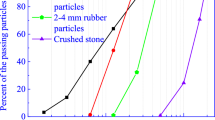Abstract
An experimental investigation was carried out to study the effects of various percentages of fine/coarse tire waste and microsilica at various temperatures on the compressive strength of concrete. The compressive strength of concrete mixtures made with tire rubber was assessed statistically with those of concrete containing microsilica and conventional concretes in order to evaluate the usefulness of recycling rubber waste as a component of concrete. Results confirmed that the recipe and processing temperature of concrete cubes influence the compressive strength values. Generally, the use of microsilica or fine rubber mixed with microsilica as aggregate replacement of 5% by volume improved the compressive strength of concrete processed at a temperature of 150°C. The addition of coarse rubber did not achieve any increase in strength when used as an aggregate replacement at any percentage. Moreover, the reductions in the compressive strength of concrete mixes at higher temperatures were much smaller for the fine rubber with 5 vol% microsilica than those for control and coarse rubber mixes. The specimens made with fine rubber and 5 vol% microsilica at elevated temperatures above 400°C appeared to show very similar compressive strength values. The use of fine rubber in building construction could help save energy and reduce costs and solve the solid waste disposal problem posed by this type of waste.
Similar content being viewed by others
References
United States Environmental Protection Agency (1991) Markets for scrap tires. The Agency, Washington, DC
Ministry of Interior (2006) Traffic report: plan needed to tackle traffic. Traffic Department, Kuwait
Day KE, Holtze KE, Metcalfe-Smith JL, Bishop CT, Dutka BJ (1993) Toxicity of leachate from automobile tires to aquatic biota. Chemosphere 27(4):665–675
Nelson SM, Mueller G, Hemphill DC (1994) Identification of tire leachate toxicants and a risk assessment of water quality effects using tire reefs and canals. Bull Environ Contam Toxicol 52: 574–581
Hartwell SI, Jordahl DM, Dawson CEO, Ives AS (1998) Toxicity of scrap tire leachates in estuarine salinities: are tires acceptable for artificial reefs? Trans Am Fisheries Soc 127(5):796–806
Chen S, Su H, Chang J, Lee W, Huang K, Hsieh L, Huang Y, Lin W, Lin C (2007) Emissions of polycyclic aromatic hydrocarbons (PAHs) from the pyrolysis of scrap tires. Atmos Environ 41: 1209–1220
Al-Mutairi N, Haque N (2003) Strength and durability of concrete made with crushed concrete as coarse aggregates. Advances in waste management and recycling conference. University of Dundee, Dundee, Scotland, September 16–18, 2003, pp 9–11
Terro M, Al-Ghussain I (2003) Mechanical properties of concrete made with treated wastewater at ambient and elevated temperatures. Kuwait J Sci Eng 30(1):229–243
Al-Ghussain I, Terro M (2003) Use of treated wastewater for concrete mixing in Kuwait. Kuwait J Sci Eng 30(1):213–328
Al-Mutairi N, Terro M, Al-Khaleefi A (2004) Effect of recycling hospital ash on the compressive properties of concrete: statistical assessment and predicting model. Build Environ J 39(5):557–566
Senthamarai R, Devadas M (2005) Concrete with ceramic waste aggregate. Cem Concr Compos 27:910–913
Eldin N, Senouci A (1993) Rubber-tire particles as concrete aggregate. ASCE J Mater Civ Eng 5:478–496
Khatip Z, Bayomy F (1999) Rubberized Portland cement concrete. J Mater Civ Eng ASCE 11(3):206–213
Li Z, Li F, Li L (1998) Properties of concrete incorporating rubber tyre particles. Mag Concr Res 50(4):297–304
Raghavan D, Huynh H, Ferraris C (1998) Workability, mechanical properties, and chemical stability of a recycled tyre rubber-filled cementitious composite. J Mater Sci 33:1745–1752
Segre N, Joekes I (2000) Use of tire rubber particles and addition to cement paste. Cem Concr Res 30:1421–1425
Tawaza E, Yonekura A (1991) Drying shrinkage and creep of concrete with condensed silica fume. American Concrete Institute, SP91-43, Farmington Hills, pp 903–921
Sandvik M, Gjorv OE (1991) Effect of condensed silica fume on the strength development of concrete. American Concrete Institute, SP91-2, Farmington Hills, pp 893–901
Bentur A (1991) Advances in cementitious materials. Ceramic Trans 16:523
Sullivan PJE, Sharshar R (1992) The performance of concrete at elevated temperatures (as measured by the reduction in compressive strength). Fire Technol 28(3):240–250
Terro MJ, Sawan JS (1998) Compressive strength of concrete made with silica fume at elevated temperatures. Kuwait J Sci Eng 25:129–144
Xu Y, Wong YL, Poon CS, Anson M (2001) Impact of high temperature on PFA concrete. Cem Concr Res 31(7):1065–1073
Kodur VKR, Wang TC, Cheng FP (2004) Predicting the fire resistance behaviour of high-strength concrete columns. Cem Concr Compos 26(2):141–153
Poon CS, Azhar S, Anson M, Wong YL (2003) Performance of metakaolin concrete at elevated temperatures. Cem Concr Compos 25(1):83–89
Savva A, Manita P, Sideris KK (2005) Influence of elevated temperatures on the mechanical properties of blended cement concretes prepared with limestone and siliceous aggregates. Cem Concr Compos 27(2):239–248
ASTM C136 (2004) Annual book of ASTM standards. American Society for Testing and Materials, West Conshohocken
American Public Health Association, American Water Works Association, and Water Environment Federation (1999) Standard methods for the examination of water and wastewater, 20th edn. APPH, Washington, DC
ASTM C305 (2004) Standard practice for mechanical mixing of hydraulic cement pastes and mortars of plastic consistency, annual book of ASTM standards, 04.01. ASTM, West Conshohocken
ASTM C192 (2004) Standard practice for making and curing concrete test specimens in a laboratory, Annual book of ASTM standards. ASTM, West Conshohocken
Neville AM (2002) Properties of concrete, 3rd edn. Longman, Harlow
Schneider U (ed) (1986) Properties of materials at high temperatures — concrete, 3rd edn. RILEM Report, Kassel University, Kassel
BS 1881 Part 116: Method for determination of compressive strength of concrete cubes. British Standard Institution, London
Box G, Hunter W, Hunter J (1978) Resolution III designs: bicycle examples. In: Statistics for experimenters. Wiley, New York
Author information
Authors and Affiliations
Corresponding author
Rights and permissions
About this article
Cite this article
Al-Mutairi, N., Al-Rukaibi, F. & Bufarsan, A. Effect of microsilica addition on compressive strength of rubberized concrete at elevated temperatures. J Mater Cycles Waste Manag 12, 41–49 (2010). https://doi.org/10.1007/s10163-009-0243-7
Received:
Accepted:
Published:
Issue Date:
DOI: https://doi.org/10.1007/s10163-009-0243-7




